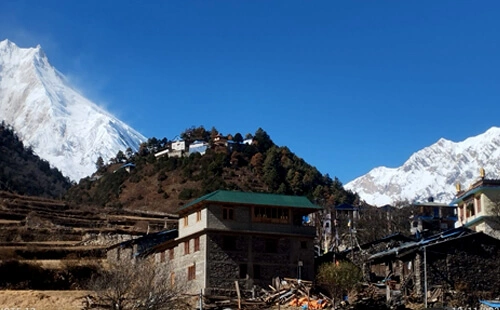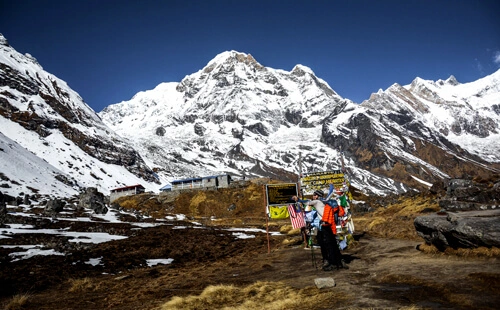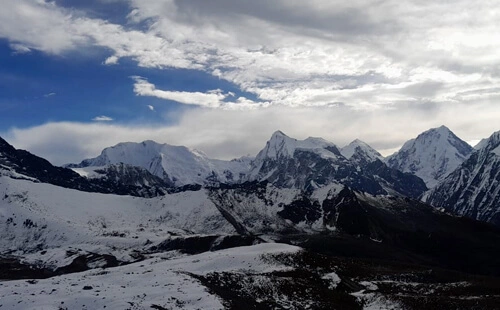For an incredible personalised experience and services
Usually, small groups provide a more individualized Everest Base Camp and Kala Patthar hiking experience where like-minded adventurers get to form stronger bonds, fostering a sense of camaraderie and shared interest, while each of the trekkers receives individualized attention from guides regarding the region's top highlights and the secret gem.
With a limited group size to go on an adventurous expedition to the combined Himalayan journey to the Everest Base Camp and Kala Patthar, you can look forward to having your specific needs and preferences met along with the valuable, precise guidance on the trekking route you are traversing, including the potential hazards, ways to prevent or minimize them, and the best method to make the overall venturing to the Everest region more fulfilling than ever.
Wonderful Flexibility in itinerary
Unlike larger group treks to explore the Everest Base Camp and Kala Patthar, where you might be obligated to stick to certain days' itinerary it can get quite hectic to make changes at the moment regarding the trekking routes and other logistics even in unforeseen circumstances, a small group joint hike to Everest Base Camp and Kala Patthar generally offers you the great flexibility to adapt to the changing circumstances, mostly crucial at the highly elevated low oxygen level, a thorough discovery, and make the most of every moment in the Himalayas at your own pace.
In a small group setting, the decisions about the itinerary for the Everest Base Camp and side trek to the Kala Patthar can be made collectively, taking into account the preferences, interests, and abilities of all participants, ensuring the happiness and memorable journey each trekker and traveler is desirous of relishing during their holiday in the Himalayas of Nepal. Further, small groups allow for more flexibility to venture side trails, visit traditional Himalayan villages, or take detours to secret gems along the way for a more leisurely experience while adjusting the route accordingly.
If there’s a particular destination you are curious about or wish to explore more, a small group heading to the Everest Base Camp and Kala Patthar can help make it possible.
Leave a less environmental impact
While larger group treks to the Everest Base Camp and Kala Patthar can have a greater environmental impact on the fragile ecosystems along the trekking routes, small groups can focus on minimizing the environmental and carbon footprint by practicing responsible waste management, such as prioritizing reusable, eco-friendly products and purchasing refillable water bottles instead of bottled water.
In addition, smaller trek groups moving forth to the Everest Base Camp and Kala Patthar tend to exert less pressure on the landslide-vulnerable terrains, comparatively, with a low detrimental effect on the environment, including trampling of vegetation and disturbance to the wildlife habitats protected under the Sagarmatha National Park, mitigating crowding due to a smaller number of visitors at a time.
The true sense of raw Himalayan Wilderness
Despite being a popular high Himalaya hiking destination, the trekking trail to the Everest Base Camp and Kala Patthar beholds some of the less traversed sections that still retain the authentic feel of the remote and untouched Everest region of the Himalayas, providing you with easier access to the off-the-beaten-path when embarking with a small group.
Additionally, along with its own set of challenges, trekking to the Everest Base Camp and Kala Patthar provides you with an opportunity to interact with local Sherpa communities and learn the original way of Himalayan life while you make your way through high altitude, unpredictable weather, and rugged terrain each day, bringing discoveries and unexpected encounters, whether you are hopeful of spotting wildlife or watching a stunning Himalayan panoramic sunrise, which is more fun and exciting than joining one of the small groups heading to the Everest Base Camp and Kala Patthar exploration.
Hence, for a better confrontation of the Everest Base Camp and Kala Patthar trekking route challenges to foster a deeper connection with the natural environment, cultural exchanges, enriching experiences, and true appreciation of the region’s cultural heritage while you push your limits in a safe and supportive setting assured by professional guides, a small group trek to the Everest Base Camp and Kala Patthar is way better than journeying with larger groups.
Quality in Service
With a smaller trekking group size to the Everest Base Camp and Kala Patthar, ranging from 10 to 12 members of expeditors, trekkers often opt for a higher standard of services, including accommodation, meals, and others, along with emotional support in need.
Generally, during the small group voyage to the Everest Base Camp and Kala Patthar, the accommodation in priority is comfortable and well-maintained, including cozy and comfortable tea houses or lodges with neat and clean bedding and hot showers, followed by a nutritious diet usually prepared with fresh and organic ingredients, ensuring trekkers and travelers a hassle-free stay after a 5- to 6-hour day of rambling at highly elevated Himalayan terrain.
Utmost safety and support during small group hike to the Everest Base Camp and Kalapatthar
A small group odyssey to the Everest Base Camp and Kala Patthar is led by certified and professional guides well trained in Himalayan wilderness and first aid, usually equipped with emergency protocols, who closely monitor the trekker’s health, pace, and needs at the moment, providing altitude advice, and are in a ready state to handle any emergency effectively.
These guides during your thrilling journey to the Everest Base Camp and Kalapatthar offer you valuable insight into the local culture, traditions, and other highlights, guidance on basically an unfamiliar route to you, and amazing leadership throughout the trek, keeping the unpredictable weather patterns and potential hazards of the Everest region at a consideration.
Further, small group treks to any Himalayan trekking, such as the Manaslu Circuit Trek, Annapurna Circuit Voyage, the Annapurna Base Camp Odyssey, etc., including the combined higher Himalayas tour to the Everest Base Camp and Kala Patthar, often provide porter service, relieving trekkers of carrying heavy backpacks so that all trekkers left to do is focus themselves in full enjoyment of the trekking experience.
The quality of experience and spiritual connection
While small group treks to Everest Base Camp and Kalapatthar may not offer complete isolation from modern civilization, the majority of trekkers tend to find smaller groups to result in a higher quality of experience throughout the entire journey while they get to center their attention more on natural beauty and self-growth with comparatively fewer distractions and a more cohesive group dynamic.
Therefore, small group treks to the Everest Base Camp and Kala Patthar are a spiritual retreat for individuals seeking spiritual renewal and introspection stemming from a genuine connection to the Himalayas that hold an extreme spiritual significance for the locals as you move through scenically profound landscapes and awe-inspiring hills and the Himalayas, connecting to something greater than yourself.
Support for local communities and conservation efforts
As many of you know, small group tours to anywhere in the Nepalese Himalayas, along with visits to the Everest Base Camp and Kala Patthar, traditionally employ local guides and porters, usually from Sherpa communities, while trekkers and travelers recurrently stay in locally owned and managed tea houses, lodges, and guesthouses along the trekking route, directly contributing to the job opportunity, income of residents, and economic sustainability of the relatively remote Everest Himalayas.
Furthermore, if you are an adventurous individual looking forward to participating in clean-up campaigns, tree-planting projects, donations, and other natural initiatives, a small group package to the Everest Base Camp and Kala Patthar can collaborate with local NGOs, community-based organizations, and cooperatives to make a positive impact on local communities and conservation efforts, relishing an unforgettable Himalayan adventure.
Surreal Cultural Encounters
Small-group trekkers are more likely to visit several historical monasteries, stupas, and other cultural highlights of the Everest region, including remote villages, giving you an opportunity for more fascinating engagement with the natives from the Himalayas, along with participation in cultural ceremonies, local festivals, and celebrations, depending on the time of year you are visiting the Everest Base Camp and Kala Patthar.
Likewise, a small group trek to the Everest Base Camp and Kala Patthar provides you with ample opportunity to capture stunning photographs, from the traditional architecture of the Everest region and intricate prayer flags to the pleasing hospitality of the Sherpa people. At the same time, you exchange cultures amidst each other, giving you a chance to document the rich tapestry of the Himalayan culture and the enriching mountainous lifestyle.
To conclude, although the small group trek to the Everest Base Camp and Kala Patthar might charge you slightly more than the larger group journey, for a well-rounded and impressive adventure that emphasizes quality, safety, cultural engrossment, an eco-friendly approach to the environment, spiritual experiences, a flexible itinerary, and scenic opportunities for photography and personal fulfillment, a small group trek to the Everest Base Camp stands out.
Rember us, Adventure Himalayan Travels and Treks, for an incredible small group expedition to the most stunning edges of the Himalayas of Nepal, Bhutan, Tibet, and India, including Everest Base Camp and Kala Patthar Trek, where we, as one of the leading local travel, tour, and trek operators, provide you with a special discount like never before, similar to that of the larger groups exceeding more than 10 trekking members.
If you are looking for a more budget-friendly, short-duration trek in the Nepalese Himalayas, you might want to consider these:




